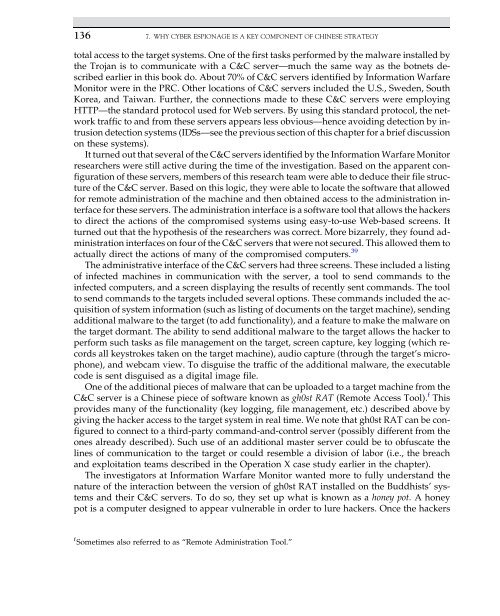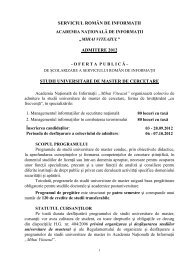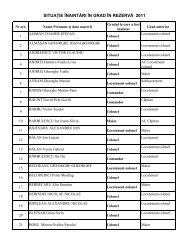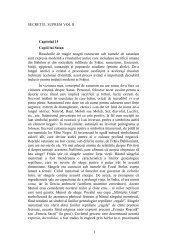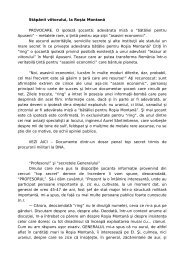Introduction to Cyber-Warfare - Proiect SEMPER FIDELIS
Introduction to Cyber-Warfare - Proiect SEMPER FIDELIS
Introduction to Cyber-Warfare - Proiect SEMPER FIDELIS
Create successful ePaper yourself
Turn your PDF publications into a flip-book with our unique Google optimized e-Paper software.
136 7. WHY CYBER ESPIONAGE IS A KEY COMPONENT OF CHINESE STRATEGY<strong>to</strong>tal access <strong>to</strong> the target systems. One of the first tasks performed by the malware installed bythe Trojan is <strong>to</strong> communicate with a C&C server—much the same way as the botnets describedearlier in this book do. About 70% of C&C servers identified by Information <strong>Warfare</strong>Moni<strong>to</strong>r were in the PRC. Other locations of C&C servers included the U.S., Sweden, SouthKorea, and Taiwan. Further, the connections made <strong>to</strong> these C&C servers were employingHTTP—the standard pro<strong>to</strong>col used for Web servers. By using this standard pro<strong>to</strong>col, the networktraffic <strong>to</strong> and from these servers appears less obvious—hence avoiding detection by intrusiondetection systems (IDSs—see the previous section of this chapter for a brief discussionon these systems).It turned out that several of the C&C servers identified by the Information <strong>Warfare</strong> Moni<strong>to</strong>rresearchers were still active during the time of the investigation. Based on the apparent configurationof these servers, members of this research team were able <strong>to</strong> deduce their file structureof the C&C server. Based on this logic, they were able <strong>to</strong> locate the software that allowedfor remote administration of the machine and then obtained access <strong>to</strong> the administration interfacefor these servers. The administration interface is a software <strong>to</strong>ol that allows the hackers<strong>to</strong> direct the actions of the compromised systems using easy-<strong>to</strong>-use Web-based screens. Itturned out that the hypothesis of the researchers was correct. More bizarrely, they found administrationinterfaces on four of the C&C servers that were not secured. This allowed them <strong>to</strong>actually direct the actions of many of the compromised computers. 39The administrative interface of the C&C servers had three screens. These included a listingof infected machines in communication with the server, a <strong>to</strong>ol <strong>to</strong> send commands <strong>to</strong> theinfected computers, and a screen displaying the results of recently sent commands. The <strong>to</strong>ol<strong>to</strong> send commands <strong>to</strong> the targets included several options. These commands included the acquisitionof system information (such as listing of documents on the target machine), sendingadditional malware <strong>to</strong> the target (<strong>to</strong> add functionality), and a feature <strong>to</strong> make the malware onthe target dormant. The ability <strong>to</strong> send additional malware <strong>to</strong> the target allows the hacker <strong>to</strong>perform such tasks as file management on the target, screen capture, key logging (which recordsall keystrokes taken on the target machine), audio capture (through the target’s microphone),and webcam view. To disguise the traffic of the additional malware, the executablecode is sent disguised as a digital image file.One of the additional pieces of malware that can be uploaded <strong>to</strong> a target machine from theC&C server is a Chinese piece of software known as gh0st RAT (Remote Access Tool). f Thisprovides many of the functionality (key logging, file management, etc.) described above bygiving the hacker access <strong>to</strong> the target system in real time. We note that gh0st RAT can be configured<strong>to</strong> connect <strong>to</strong> a third-party command-and-control server (possibly different from theones already described). Such use of an additional master server could be <strong>to</strong> obfuscate thelines of communication <strong>to</strong> the target or could resemble a division of labor (i.e., the breachand exploitation teams described in the Operation X case study earlier in the chapter).The investiga<strong>to</strong>rs at Information <strong>Warfare</strong> Moni<strong>to</strong>r wanted more <strong>to</strong> fully understand thenature of the interaction between the version of gh0st RAT installed on the Buddhists’ systemsand their C&C servers. To do so, they set up what is known as a honey pot. A honeypot is a computer designed <strong>to</strong> appear vulnerable in order <strong>to</strong> lure hackers. Once the hackersf Sometimes also referred <strong>to</strong> as “Remote Administration Tool.”


